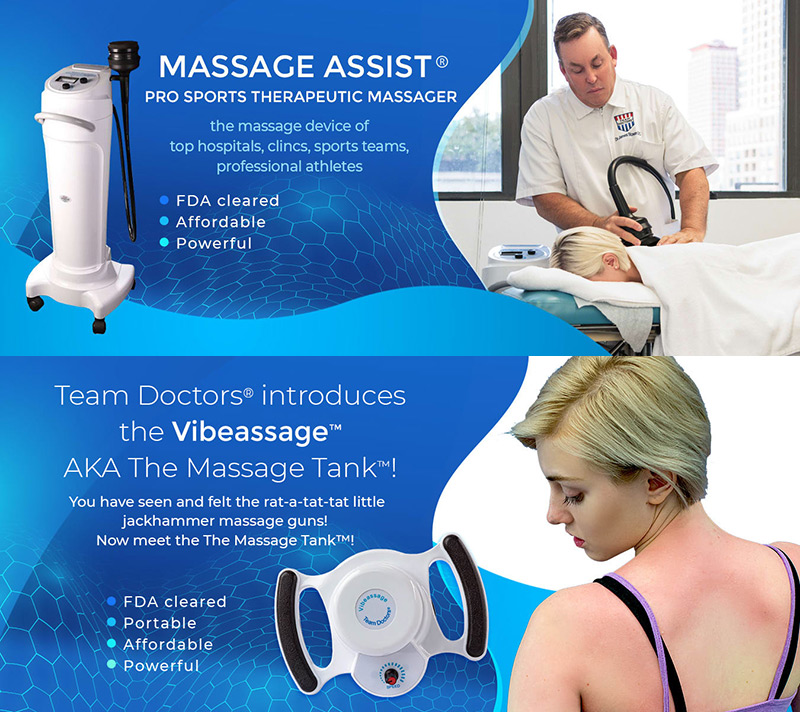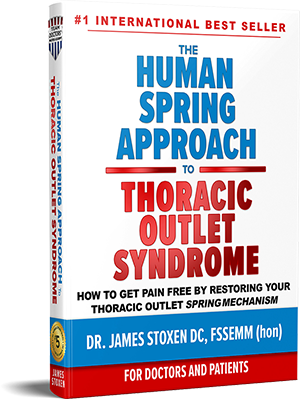You are reading Preface – Introduction – The Sonny Burke Story
Thoracic Outlet Syndrome ICD-9 353.0
Tips For Better Health
Ask the doctor, Dr James Stoxen DC
Table of Contents
Preface
Introduction
The Sonny Burke Story
Chapter I What is Thoracic Outlet Syndrome? (TOS)
Chapter II Anatomy
Chapter III The TOS Controversy
Chapter IV History, Cause, and Patient Presentations
Chapter V Physical Examination Findings
Chapter VI Diagnostic Tests
Chapter VII Standard of Care Approaches – Surgical and Non-Surgical
Chapter VIII Frequently Asked Questions
Chapter IX Case Histories of Patients
Chapter X The Human Spring Approach to Treatment and Prevention
Preface
Patients come from around the world for treatment for Thoracic Outlet Syndrome by Dr. James Stoxen DC at Team Doctors. The results are not predicated on visits with our approach. The results come with how many hours Dr Stoxen spends resetting the mechanism. For those of you from outside Chicago, we have accelerated treatment plans that allow you to be treated all day for several days in a row until the condition is resolved to MMI.
A note from Dr Stoxen…..
“Thoracic outlet syndrome is one of the most commonly misdiagnosed, mistreated, under-treated conditions in medicine. Many of my patients come to me from around the world. They have commonly already been to many of the top specialists in a few branches of medicine and have tried many standard treatment approaches and yet are still suffering. I have had some patients that have been to over 20 doctors before coming to Team Doctors. The reasons why these standard approaches fail and the keys to proper examination, treatment, and prevention are revealed in this complete article below.
This article gets over 6,000 views a month. Because of it’s importance, I am in the process of writing a book about thoracic outlet syndrome. When the book is complete this article will be removed from the site. If you find this information invaluable print the article now and sign up for our newsletter so we can let you know when it’s released.”
Please feel free to ask any question you like and even share your experience in the comments section at the bottom. I promise I will respond quickly and decisively.”
–Dr. James Stoxen DC
The Sonny Burke Story:
Sonny Burke is a music legend. The Roselle native played piano for Smokey Robinson for 34 years. As a top studio musician he played on over 200 record albums and 1000 musical assignments including the entire Saturday night fever album, Jackson 5, Dancin Machine, and other Grammy award-winning artists.
One day Sonny couldn’t play at all….he was completely numb and too weak play. He couldn’t even button his shirt.
“It had been going on for four years. I couldn’t even make a fist,” he said. “I went to five top doctors. First they told me I had unlnar nerve entrapment. I had surgery for that and it did nothing. While I was recovering from the surgery the numbness and tingling started spreading across my entire left hand then went up my entire left arm. A few weeks later my right hand started going numb. I progressively lost grip strength which baffled all the top doctors I went to. Then they diagnosed me with diabetic neuropathy. They said nothing could be done about that. I had to live with it.
Yet now the legendary pianist is back playing again. “I can’t believe it,” says Burke. “In three weeks my hand strength has gone from 2% to almost normal.”
“I had given up hope for a cure for my numbness and severe weakness after seeing 5 top doctors who operated on me and did every test and treatment they knew including surgery. They finally told me there was nothing that could be done so I had to retire from music.”
“Then I was introduced to Dr Stoxen by a friend backstage at a Steely Dan Concert.”
Sonny Burke didn’t have ulnar nerve entrapment, he didn’t need surgery, and he didn’t have diabetic neuropathy.
His real problem was called Thoracic Outlet Syndrome (TOS).
“When he told me he had diabetic neuropathy I didn’t think I could help him. My only hope was that he was misdiagnosed. When he told me he watched TV in bed…then I knew it could be TOS,” said Dr. James Stoxen of Chicago. The expert lectures on the condition worldwide.
Burke would probably still be helpless….if Steely Dan hadn’t recently come to Chicago.
He worked that night backstage with the group (and over 200 other visiting top recording artists). At dinner Steely Dan’s bass player, Freddie Washington, saw how helpless his friend Burke had become, he brought Sonny backstage to meet Dr Stoxen.
“After a thorough exam, the diagnosis was obvious,” says the chiropractor. “This is one of the most common, and commonly misdiagnosed, conditions in America.”
And the biggest cause of the problem?
“By far,” says Stoxen, “it’s watching too much TV in bed, leaning back in the car while driving, poor posture and ergonomics at the computer, text messaging, and other hand held apparatus. In fact, this problem barely existed until all-night programming.”
The problem for Sonny was this. While on tour for months at a time, his routine was to lay in bed for hours watching TV while propped up with a pillow waiting for the limo to come take him to the show.
“We don’t realize it but we keep our 8-10 pound head suspended from our neck by contracting neck muscles called the scalenes. Those muscles run from the back of the head to the first and second rib.”
“The head weighs as much as a bowling ball,” says Stoxen. “Watch TV in bed, even with a pillow, and those muscles are constantly contracted for hours at a time. It’s similar to holding a ten pound weight at arm’s length. What happens? Your scalenes go into constant spasm, they fatigue and then they contract constantly in a spasm compressing the neck and the outlet which the nerves, arteries and veins pass through to the arm.”
The scalenes swell compressing the artery, vein and nerves as they pass through them, they lift the first rib up constantly which brings it closer to the collar bone and the chest muscles pull the shoulder and collar bone down too.
That combination of events compresses the nerves and vessels against the overlying collarbone, and causes the symptoms of TOS. Besides weakness, those symptoms can include tingling, neck pain, shoulder problems, and headaches. When it’s really bad it can cause clot formation, loss of the limb, permanent disability or even death, if the clot releases
Dr. Stoxen says, “unfortunately, most TOS patients are misdiagnosed and many receive unnecessary surgery. “Like Mr. Burke they’re mistakenly told they have herniated disc with a pinched nerve, diabetic neuropathy, carpal tunnel syndrome, or just think the patient is psychologically effected.”
To treat Burke’s real problem, first Stoxen had him move his TV out of his bedroom and advised him to sit up straight at all times. Next he repositioned the structures surrounding the thoracic outlet with a combination of unique hands on procedures he has developed followed by a specially designed rehabilitation exercise program.
“It takes me several hours to completely rebuilt the area of his neck and shoulders surrounding the outlet by hand,” he says. “Gradually, (after about ten treatments) the blood flow returns to the arms and hands, the feeling came back and Sonny’s strength came back.”
Doctors and patients do not realize how much work is involved in reversing thoracic outlet. Most cases take 10 – 35 hours of hard core deep tissue to clear this up. It is analogous to unraveling a pile of frozen steak and entwined wires with your bare hands.
Many patients with Burke’s symptoms ultimately get surgery. In 22 years of practice I have not sent a single patient for neck surgery and I treat some tough cases.”
“If you’ve noticed those tingling or weakness of your hands since the conventions, don’t just allow yourself to get possible unnecessary surgery,” says Stoxen. “Your real problem may be treatable with these methods.
Do you have Thoracic Outlet Syndrome? You likely feel this pain in your neck, arm or hand. It’s often an electrical or throbbing feeling that travels down your arm and can make your hands weak. In this book you will find every thing you ever wanted to know about Thoracic Outlet Syndrome.
Introduction
What is Thoracic Outlet Syndrome?
Thoracic outlet syndrome, also called thoracic outlet disorder which is a group of symptoms such as arm and neck pain or under shoulder pain, caused by pressure against the bundle of nerves and/or the arteries and veins that originate at the spinal cord at the neck as they pass through the scalene muscles, over the first rib and under the pectoralis minor and clavicle (collar bone), or collar bone muscle.
The other diagnostic labels that have been used to describe thoracic outlet syndrome are: Cervical rib syndrome, scalenus anticus syndrome, costoclavicular syndrome, hyper abduction syndrome, pectoralis minor syndrome, brachiocephalic syndrome, nocturnal paresthetic brachialgia, fractured clavicle-rib syndrome, deep vein thrombosis (Paget-Schroetter syndrome), superior outlet syndrome, naffziger syndrome, subcoracoid pectoralis minor syndrome, first thoracic rib syndrome, costoclavicular compression syndrome and cervical rib and band syndrome.
Thoracic Outlet Syndrome or the diagnosis of Thoracic outlet syndrome is the name given to several similar problems that can include arm pain from the neck which involves compression of the nerves and blood vessels of the area where your neck attaches to your body — the lower neck / upper chest region. It can also entail a pinching off of an artery that runs underneath the clavicle (subclavian artery). This causes arm numbness, arm tingling, or your arm in pain and often times pain in the hands that is often mistaken for carpal tunnel syndrome.
Thoracic Outlet Syndrome (TOS) is not only difficult to diagnose, many physicians deny its very existence. The truth is that inside the medical community, Thoracic Outlet Syndrome (TOS) is not well understood, difficult to image, and carries a great deal of controversy and disagreement over how best to treat it. In this article I will explain diagnosing for thoracic outlet syndrome, testing for thoracic outlet syndrome, symptoms of thoracic outlet syndrome and treatment for thoracic outlet syndrome.
This is one reason why so many people who have been told they have thoracic outlet syndrome contact me, a thoracic outlet syndrome specialist. Many of you are getting thoracic outlet treatment yet are still experiencing thoracic outlet pain, headaches, achy hands, tingling in the fingers, shoulder pain, below neck pain, upper back pain, chest pain with arm pain, swelling in the hands and even loss of grip strength thinking thoracic outlet surgery is the only option.
Some patients have symptoms of nerve compression, which causes severe neck pain, repeated migraines, shoulder pain, and a sense of tiredness or heaviness in the arm caused by thoracic outlet syndrome. Other symptoms of thoracic outlet syndrome may include tenderness over the neck muscles or around the collarbone, pressure on these areas causing pain or tingling in the arm, pain in the shoulder or arm with neck movements, and tenderness in the armpit. Even odd sensations in the face or ringing in the ear or ear pain can be caused by thoracic outlet syndrome.
The nerves supply sensation and muscle power to the arms and the arteries and veins provide blood supply to the arm. The pressure against these structures is caused by tight swollen scalene muscles, in the neck, shoulder and chest muscles as well as an elevated first rib with a depressed collarbone. There are many areas nerve compression, for these arteries and nerves to get compressed.
That is why you need to know the thoracic outlet anatomy so you can differentiate between venous thoracic outlet, arterial thoracic outlet syndrome, (vascular thoracic outlet), cervical ribs thoracic outlet syndrome, carpal tunnel syndrome. Thoracic outlet brachial plexus compression (neurogenic thoracic outlet), pectoralis minor thoracic outlet syndrome, or maybe you have all of the above!
Watch above as Dr. James Stoxen DC gives the lecture presentation Thoracic Outlet Syndrome at the 12th Annual World Congress on Anti-aging Medicine Mandalay Bay Hotel and Casino, Las Vegas Nevada December 4, 2004
All of the keys to proper examination, treatment, and prevention of Thoracic Outlet Syndrome are found in the latest edition of “THE HUMAN SPRING BREAKTHROUGH SOLUTION TO THORACIC OUTLET SYNDROME”
READ MORE POSTS ON THORACIC OUTLET SYNDROM

www.thoracicoutletsyndrome.com







